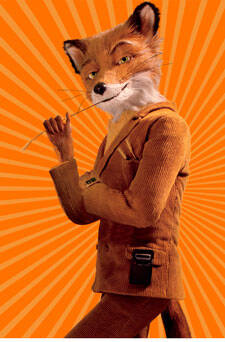The world of director Wes Anderson is one in which color, slow-motion and classic rock play roles as prominent as the dysfunctional-yet-loving characters that grace the screen. Anderson’s latest film, Fantastic Mr. Fox, based on the book by Roald Dahl, is no exception. Mr. Fox and his family and friends live in a land colored exclusively in autumnal reds, yellows, oranges and browns. Their homes and farms are meticulously arranged, and one can occasionally catch the harmonious sound of the Beach Boys in the distance. The stop-motion animation doesn’t come close to the approximating the smooth movements of a real-life fox, and that is part of the film’s charm. The whimsy allows viewers to easily enter into the world of Roald Dahl, through the dry wit and existential angst for which Anderson is known. The result is a place where foxes strut on two legs, wear tiny suits and have checkered pasts. But Mr. Fox and his friends also live in a land with more pragmatism and depth than the quirky animation suggests.
Once a star athlete and skilled chicken thief, Mr. Fox (voiced by George Clooney) promised to give up his risk-taking ways after he learned his wife, Felicity (Meryl Streep), was pregnant. Twelve years later, he has remained faithful to that promise. But now, just shy of the age at which his own father died, Fox finds himself contemplating his own mortality and usefulness. Eager to redefine himself, he feels compelled to lift his wife; son, Ash (Jason Schwartzman); and nephew, Kristofferson (Eric Anderson), literally out of the foxhole in which he feels trapped.
But a new home built in an old tree doesn’t solve Fox’s existential angst. “Who am I?” he asks Kiley (Wiley Wolodarsky), a loyal if not particularly bright opossum friend, as they stand on a balcony and look toward the farms and factories of Boggis, Bunce, and Bean, three particularly nasty farmers from whom Fox had a habit of stealing chickens in his younger days.
This simple question is the driving force behind Fox’s decision to pull one final heist. But his actions that follow threaten his marriage, his relationship with his son and ultimately his life. He is a stubborn, sly fox; an excellent athlete; a well-meaning but occasionally selfish father and husband; and as he puts it “a wild animal,” with all the qualities that come with such a title. “How can a fox ever be happy without a chicken in its teeth?” he asks.
Fox’s efforts to both tame and embrace his wild instincts are made more compelling by Ash’s quest to emerge from the shadow of his father’s success and that of his scholar-athlete cousin. Ash’s sarcasm provides some of the film’s funnier scenes as Schwartzman seems to channel the more earnest elements of Max Fisher, the precocious character he played in Anderson’s “Rushmore.” Still, in the midst of many humorous moments, the film does not avoid tackling tough questions—of redemption, identity, community, survival—which lend a heavier-than-usual tone to a movie many children will see.
One scene may be especially frightening for children. In the wake of a fight an animal dies, but not before he has a last-minute change of heart. Ash remarks, “He redeemed himself.” But Fox simply replies, “Redemption? Maybe. But in the end he’s just another dead [animal] in a dumpster behind a Chinese restaurant.” Whether Fox’s words echo the callous attitude of the farmers or his own philosophy is unclear. But the ambiguity surrounding the character’s death is unsettling. How does one go on living a life seemingly destined to end with the bang of a dumpster door? It is a troubling philosophical question for viewers of any age.
There is a cold artificiality to the world constructed by Boggis, Bunce and Bean. When the farmers aren’t separating themselves from nature with gray concrete walls and fluorescent lighting, they are actively destroying it in both obvious (digging with backhoes) and subtle (selling apples decorated with gold stars) ways. Theirs is a paler version of Mr. Fox’s world, and constantly presents threats to Fox’s survival.
But Fox’s greatest weapon turns out not to be any tool or talent, but his relationships with his family and friends, the individuals who sometimes have taken second place to his own ego. Fox recognizes the best qualities in each animal, calls each by its species scientific Latin name and demands that each proclaim a talent. Mole has night vision; Rabbit has speed; Badger is a demolitions expert. Fox, perhaps echoing St. Ignatius, calls on every animal to use his unique gift for the benefit of all. (Moles and Badgers for Others?)
Still, the animals’ future at the end of the film remains uncertain. Elements of normal life remain as animals take up their old jobs and even meditation. They will continue to steal and eat and love and learn, but the lives of Fox and his friends will never be the same.
But no external change can suppress the true nature of Mr. Fox, who remains a wild animal. His willingness to take risks now brings not embarrassment, but hope to his family and newfound community. He is moved to make a toast, not to his success, but to survival.
From now on, the lives of Fox and his friends will be more complicated. They are inextricably linked to the very farmers they sought to subvert. But they will survive. Though the peace they have won is precarious, Mr. Fox is more confident, more himself than ever. He is also overcome with gratitude and love. So, in spite of all their troubles, he and his loved ones begin to dance. Although, for now, they must exist in a world that at times seems grey and artificial, processed and repackaged, it is clear that they will rise, fantastically, above it all.








